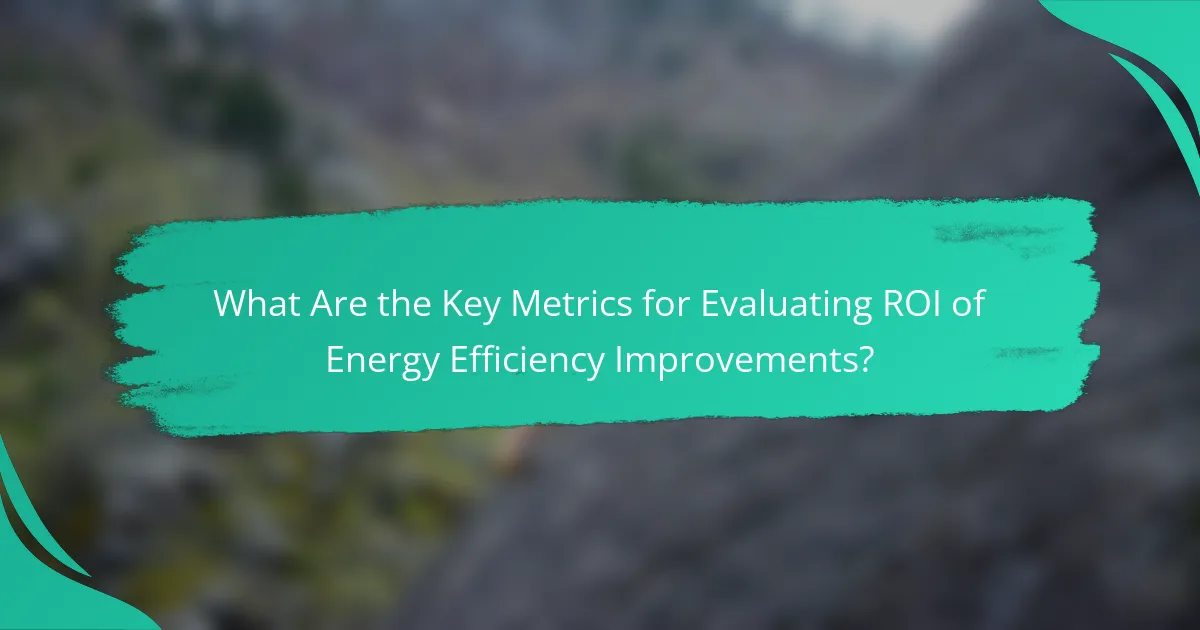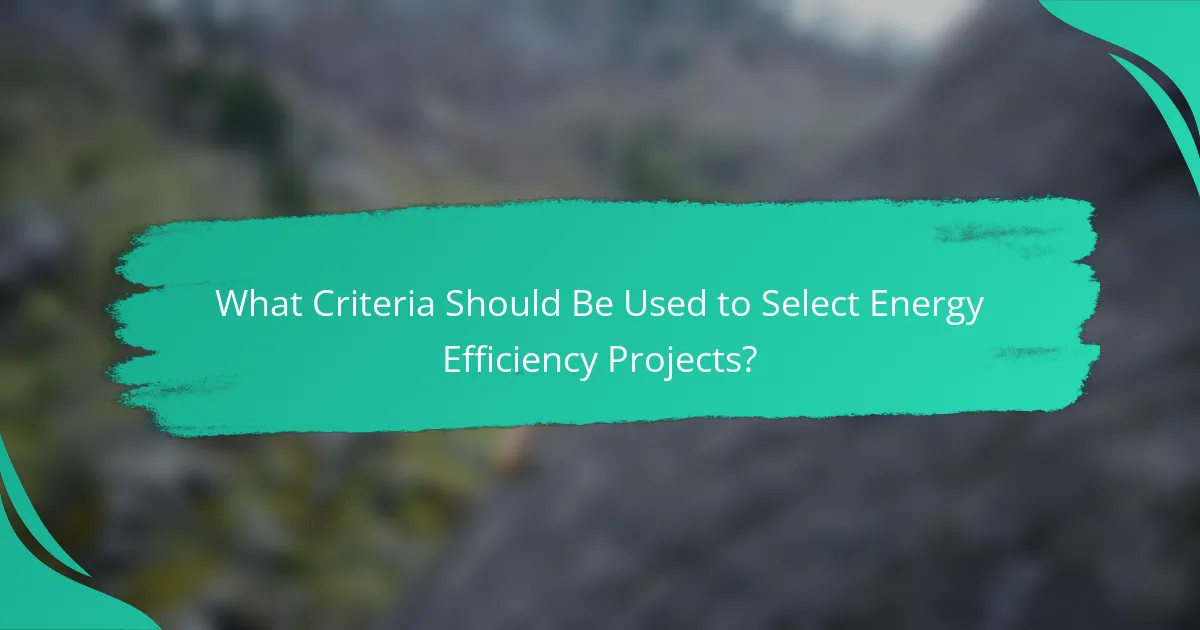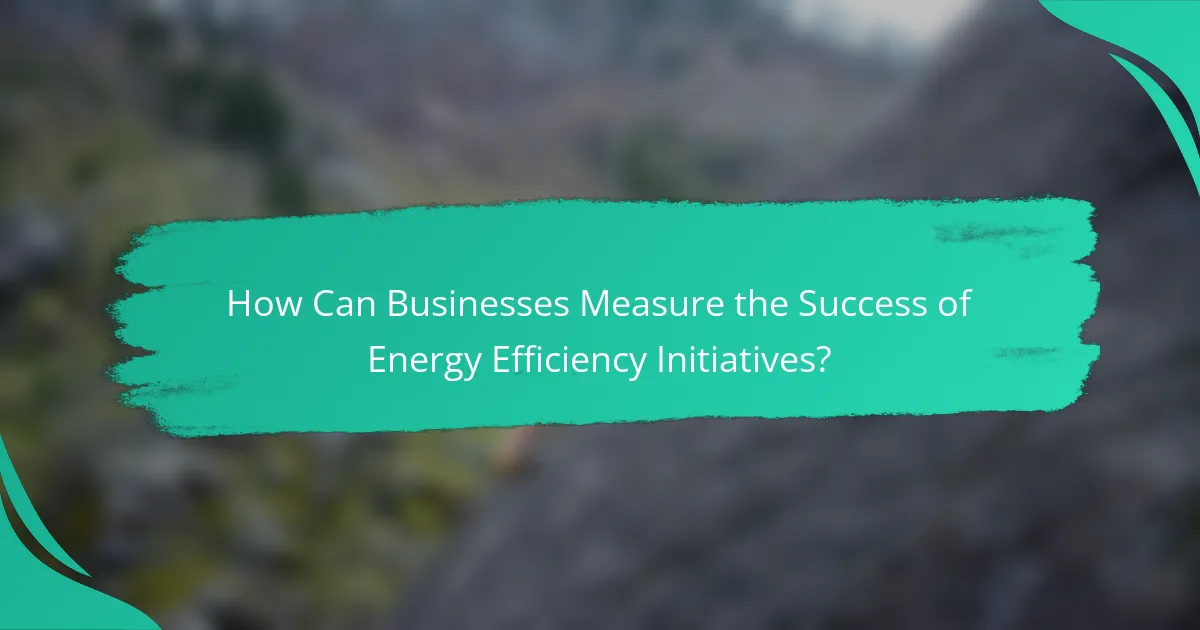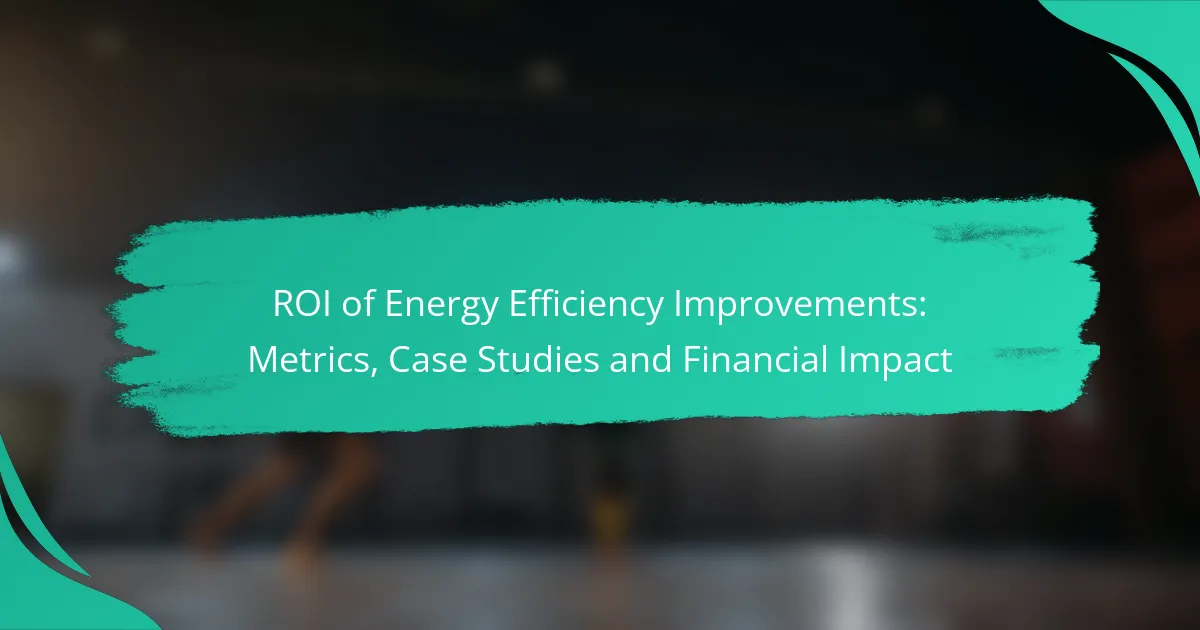Understanding the ROI of energy efficiency improvements is crucial for organizations aiming to enhance their financial performance while reducing environmental impact. By evaluating key metrics such as energy cost savings and payback period, businesses can make informed decisions that lead to lower operating expenses and increased asset value. Real-world case studies further demonstrate the tangible benefits of these initiatives, showcasing successful implementations that yield significant financial returns and operational efficiencies.

What Are the Key Metrics for Evaluating ROI of Energy Efficiency Improvements?
The key metrics for evaluating the ROI of energy efficiency improvements include energy cost savings, payback period, net present value, internal rate of return, and carbon footprint reduction. These metrics help organizations assess the financial benefits and environmental impact of their energy efficiency initiatives.
Energy Cost Savings
Energy cost savings represent the reduction in utility bills resulting from energy efficiency improvements. Organizations should calculate these savings by comparing pre- and post-implementation energy costs, considering factors like energy rates and usage patterns.
For example, a commercial building that reduces its energy consumption by 20% could see annual savings ranging from hundreds to thousands of dollars, depending on its size and energy rates. Tracking these savings over time is crucial for understanding the long-term benefits of energy efficiency investments.
Payback Period
The payback period measures the time it takes for an investment in energy efficiency to pay for itself through cost savings. This metric is calculated by dividing the initial investment by the annual energy cost savings.
A typical payback period for energy efficiency projects can range from 1 to 5 years, depending on the technology and implementation costs. Shorter payback periods are generally more attractive, as they indicate quicker returns on investment.
Net Present Value
Net present value (NPV) assesses the profitability of an energy efficiency project by calculating the difference between the present value of cash inflows (savings) and outflows (costs). A positive NPV indicates a worthwhile investment.
To calculate NPV, organizations should consider the expected lifespan of the energy efficiency measures and apply an appropriate discount rate. Projects with a higher NPV are typically prioritized for funding and implementation.
Internal Rate of Return
The internal rate of return (IRR) is the discount rate at which the net present value of an investment equals zero. It represents the expected annual return on investment from energy efficiency improvements.
Organizations often compare the IRR of energy efficiency projects to their required rate of return. A higher IRR suggests a more attractive investment, making it essential to evaluate this metric alongside others when making decisions.
Carbon Footprint Reduction
Carbon footprint reduction measures the decrease in greenhouse gas emissions resulting from energy efficiency improvements. This metric is increasingly important for organizations aiming to meet sustainability goals and regulatory requirements.
Calculating carbon footprint reduction involves estimating the emissions associated with energy consumption before and after implementing efficiency measures. Organizations can use this data to report on sustainability initiatives and enhance their corporate social responsibility profiles.

How Do Energy Efficiency Improvements Impact Financial Performance?
Energy efficiency improvements can significantly enhance financial performance by reducing costs and increasing asset value. These enhancements lead to lower operating expenses, improved cash flow, and greater appeal to investors.
Increased Property Value
Implementing energy-efficient upgrades can raise property values by making buildings more attractive to potential buyers and tenants. Properties that meet or exceed energy efficiency standards often command higher market prices due to lower utility costs and enhanced comfort.
For example, a commercial property with energy-efficient HVAC systems may see an increase in value of 5-15% compared to similar properties without such improvements. This appreciation can be particularly beneficial in competitive real estate markets.
Lower Operating Costs
Energy efficiency improvements lead to lower operating costs by reducing energy consumption and maintenance expenses. Upgrades such as LED lighting, high-efficiency appliances, and improved insulation can cut utility bills significantly, often by 20-30% or more.
Building owners should consider conducting an energy audit to identify potential savings. This proactive approach helps prioritize investments that yield the highest returns in reduced operating costs.
Enhanced Cash Flow
With lower operating costs from energy efficiency improvements, businesses can experience enhanced cash flow. The savings generated can be reinvested into the business or used to pay down debt, improving overall financial stability.
For instance, a company that saves $10,000 annually on energy bills can redirect those funds towards growth initiatives, thereby increasing profitability over time. This positive cash flow can also improve a company’s ability to secure financing.
Attracting Investment
Energy-efficient properties are increasingly attractive to investors, as they align with sustainability goals and offer lower risk profiles. Investors are often willing to pay a premium for assets that promise reduced operational costs and stable returns.
To attract investment, property owners should highlight energy efficiency certifications, such as LEED or ENERGY STAR, and provide data on energy savings. This transparency can enhance credibility and appeal to environmentally conscious investors looking for sustainable opportunities.

What Are Real-World Case Studies Demonstrating ROI?
Real-world case studies provide valuable insights into the return on investment (ROI) of energy efficiency improvements. These examples illustrate how organizations have successfully implemented energy-saving measures, leading to significant financial benefits and operational efficiencies.
Case Study: Walmart’s Energy Efficiency Initiatives
Walmart has invested heavily in energy efficiency initiatives, focusing on reducing energy consumption across its stores. By implementing LED lighting, energy-efficient HVAC systems, and advanced energy management systems, Walmart has achieved substantial cost savings, reportedly reducing energy costs by tens of millions of dollars annually.
In addition to direct savings, these initiatives have enhanced Walmart’s sustainability profile, aligning with consumer preferences for environmentally responsible practices. The company aims to be powered by 100% renewable energy, further boosting its long-term ROI through reduced energy expenses and improved brand loyalty.
Case Study: Google’s Renewable Energy Investments
Google has committed to significant investments in renewable energy, aiming to operate on 100% renewable energy across its global data centers. By purchasing renewable energy through long-term power purchase agreements (PPAs), Google has not only reduced its carbon footprint but also stabilized its energy costs against market fluctuations.
The financial impact is notable, with Google reporting savings in energy costs that contribute to its overall profitability. This strategy not only provides a clear ROI but also positions Google as a leader in corporate sustainability, attracting eco-conscious consumers and investors alike.
Case Study: The Empire State Building Retrofit
The Empire State Building underwent a comprehensive retrofit to improve energy efficiency, which included upgrading windows, installing energy-efficient lighting, and enhancing the building’s heating and cooling systems. This project, costing around $20 million, is expected to yield over $4 million in annual energy savings.
By following best practices in energy efficiency retrofitting, the Empire State Building serves as a model for other commercial properties. The project highlights the importance of thorough energy audits and the integration of modern technologies to achieve significant ROI while preserving historical integrity.

What Criteria Should Be Used to Select Energy Efficiency Projects?
To select energy efficiency projects effectively, consider criteria such as cost-benefit analysis, energy audit results, and regulatory compliance requirements. These factors help prioritize initiatives that offer the best financial returns and align with legal standards.
Cost-Benefit Analysis
A cost-benefit analysis evaluates the financial implications of energy efficiency projects by comparing the expected costs against anticipated savings. This analysis typically includes initial investment, maintenance costs, and the projected reduction in energy bills over time.
When conducting a cost-benefit analysis, consider using metrics like the payback period, net present value (NPV), and internal rate of return (IRR). For instance, projects with a payback period of less than five years are often deemed favorable.
Energy Audit Results
Energy audit results provide insights into a building’s energy use and identify potential efficiency improvements. These audits assess current energy consumption patterns and highlight areas where upgrades can lead to significant savings.
Utilizing energy audit findings can guide project selection by focusing on high-impact areas, such as HVAC systems or insulation. Prioritize projects that address the most significant energy waste identified in the audit to maximize returns.
Regulatory Compliance Requirements
Regulatory compliance requirements involve adhering to local, state, or national energy efficiency standards. These regulations can influence project selection by mandating specific improvements or incentivizing certain technologies.
Stay informed about relevant regulations, such as energy efficiency standards set by the Department of Energy or local building codes. Ensuring compliance not only avoids penalties but can also unlock financial incentives, making projects more attractive.

How Can Businesses Measure the Success of Energy Efficiency Initiatives?
Businesses can measure the success of energy efficiency initiatives by tracking energy consumption, monitoring financial metrics, and conducting employee engagement surveys. These methods provide a comprehensive view of the impact of energy-saving measures on both operational costs and workplace culture.
Tracking Energy Consumption
Tracking energy consumption involves monitoring the amount of energy used before and after implementing efficiency initiatives. This can be done using smart meters or energy management software that provides real-time data. Comparing energy usage over time helps identify trends and savings achieved through efficiency upgrades.
For example, a business may find that energy consumption decreased by 20% after installing LED lighting. Regularly reviewing energy bills can also highlight savings, allowing businesses to quantify their return on investment.
Monitoring Financial Metrics
Monitoring financial metrics is crucial for understanding the economic impact of energy efficiency initiatives. Key metrics include energy cost savings, payback periods, and return on investment (ROI). Businesses should calculate the total costs of implementation against the savings generated to assess financial viability.
For instance, if an energy efficiency project costs $10,000 and results in annual savings of $2,500, the payback period would be four years. This straightforward calculation helps businesses make informed decisions about future investments in energy efficiency.
Employee Engagement Surveys
Employee engagement surveys can provide insights into how energy efficiency initiatives affect workplace morale and productivity. By asking employees about their perceptions of energy-saving measures, businesses can gauge acceptance and identify areas for improvement. Engaged employees are more likely to support and participate in energy-saving practices.
For example, a survey might reveal that employees appreciate the comfort of improved HVAC systems, which can lead to increased productivity. Regular feedback can help refine energy initiatives and ensure they align with employee needs and expectations.

What Are the Emerging Trends in Energy Efficiency Investments?
Emerging trends in energy efficiency investments focus on innovative technologies, regulatory support, and increased awareness of sustainability. Companies are increasingly adopting smart technologies and data analytics to optimize energy usage and reduce costs.
Technological Innovations in Energy Efficiency
Technological advancements are transforming energy efficiency investments. Smart meters, IoT devices, and energy management systems enable real-time monitoring and control of energy consumption. These innovations help businesses identify inefficiencies and implement targeted improvements.
For instance, retrofitting buildings with energy-efficient lighting and HVAC systems can lead to significant savings. Many organizations report reductions in energy costs by 20-50% after implementing these technologies.
Government Incentives and Regulations
Government incentives play a crucial role in promoting energy efficiency investments. Various programs offer tax credits, rebates, and grants to encourage businesses to adopt energy-saving measures. Regulations such as energy efficiency standards also drive compliance and investment in efficient technologies.
In the U.S., programs like the Energy Efficiency Improvement Act provide financial support for energy-efficient upgrades. Understanding local regulations can help businesses maximize available incentives and improve their ROI.
Growing Awareness of Sustainability
There is a growing awareness of sustainability among consumers and businesses alike, driving demand for energy-efficient solutions. Companies are increasingly recognizing that energy efficiency not only reduces costs but also enhances their brand image and meets consumer expectations.
As a result, many organizations are setting ambitious sustainability goals, such as achieving net-zero emissions. This trend is prompting investments in energy-efficient technologies and practices that align with corporate social responsibility initiatives.
